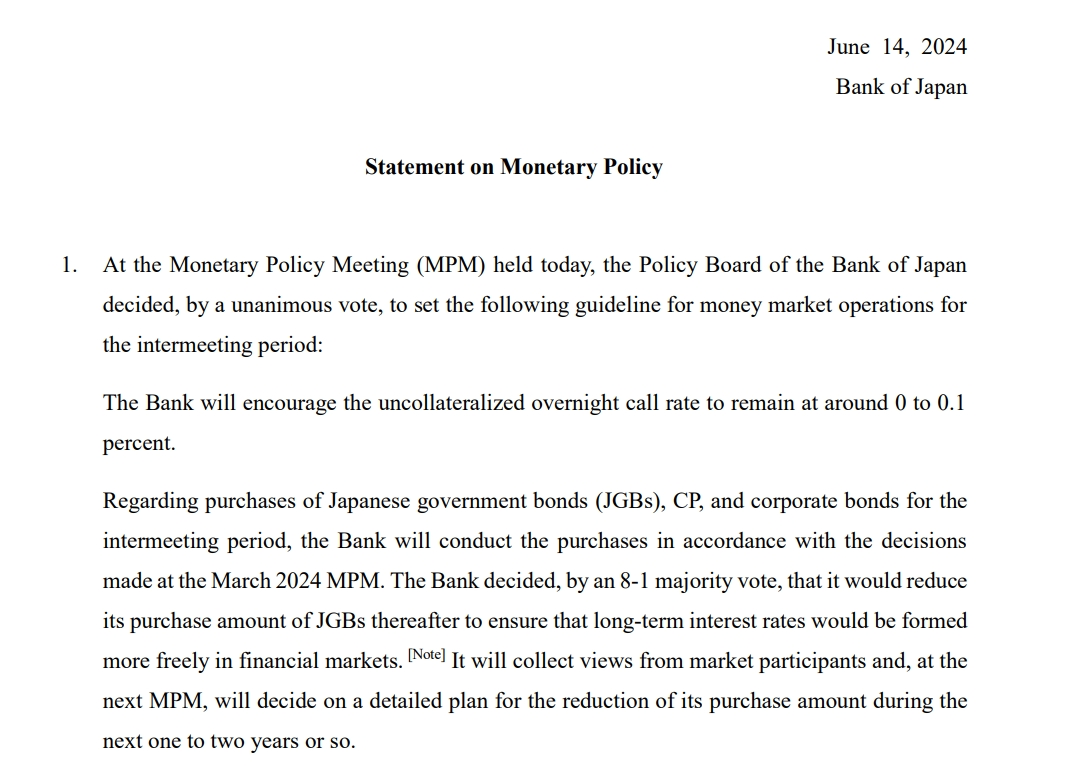Bank of Japan's June 2024 interest rate decision: Interest rates unchanged, reduction in bond purchase scale still undecided
Due to the long-term loose monetary policy, the Bank of Japan appears particularly cautious in controlling the scale of debt reduction.
On June 14, the Bank of Japan concluded its two-day monetary policy meeting, deciding to maintain the short-term interest rate at 0 to 0.1%, in line with market expectations. The Bank of Japan also announced that it would gradually reduce the scale of government bond purchases in the future, with specific reduction plans to be decided at the next meeting.

Compared to the expected interest rate decision, the Bank of Japan's reduction plan for government bonds is clearly of greater concern to the market. Under a long-term loose monetary policy, the Bank of Japan launched a large-scale government bond purchase program to lower long-term interest rates and stimulate the economy, which is equivalent to a "soft interest rate cut." Currently, the bank purchases about 6 trillion yen worth of government bonds each month, holding about half of the total government bonds.
Given the inertia formed by long-term easing, the Bank of Japan is particularly cautious about controlling the scale of bond reduction. The bank stated that it would reduce the purchase scale of Japanese government bonds in the future to allow for greater fluctuations in long-term interest rates. However, the specific bond purchase plan for the next 1-2 years will not be further clarified until the next meeting. The central bank announced the formation of a special "Bond Market Group" meeting to discuss this issue.
The market originally expected the Bank of Japan to reduce its bond purchase plan at this meeting, with a possible 25 basis point rate hike in the July meeting, but these hopes were dashed. The Bank of Japan was vague regarding bond purchases, announcing a reduction in government bond purchases but not disclosing specific plans this time.
As a result, after the interest rate decision was announced, the yen fell, with the USD/JPY rising 70 points short-term to a high of 157.77. The yield on Japan's 10-year government bonds fell, likely recording a bearish line for two consecutive weeks, while the Nikkei 225 futures turned upward, rising 0.5% at the midday opening, and the TOPIX index rose 0.7%.
Analysts say that despite Japan maintaining a relatively loose monetary policy, the country's 2% inflation target is still affected by weak domestic consumption. Sluggish domestic demand remains the biggest obstacle to the Bank of Japan raising interest rates.
According to data released on the 10th, Japan's annualized quarter-on-quarter GDP for the first quarter was revised from a decline of 2.0% to a decline of 1.8%. Although the decline has narrowed, it is still below the previous market expectation of a 1.5% decline. Data showed that Japan's personal consumption fell 0.7% quarter-on-quarter in the first quarter, marking the fourth consecutive quarter of decline, significantly contributing to the drop in Japan's first-quarter GDP.
Under the pressure of yen depreciation, the Bank of Japan currently faces a dilemma. On one hand, the weak yen has boosted foreign consumption, with Japan's tourism industry continuing to flourish this year. On the other hand, the weak yen has led to higher import costs, causing price increases that further suppress domestic consumption levels.
Analysts say that for Japanese citizens, imported inflation is gradually suppressing consumption, with both individual consumers and businesses continuously cutting spending in the first quarter, leading to increasing inventory and unsold goods. The Japanese government recently intervened twice to boost the yen, but despite unprecedented efforts, the results were minimal. Raising interest rates to reduce liquidity would also suppress consumption, indicating that "the Bank of Japan seems to be in a bind."
The latest data shows that Japan's core CPI year-on-year growth has reached between 2.0% and 2.5%, with service prices continuing to rise moderately, mainly driven by wage growth. The Bank of Japan expects underlying CPI inflation to gradually rise, as the output gap is expected to improve and medium- to long-term inflation expectations are expected to rise with the continued strengthening of the virtuous cycle between wages and prices.
Looking ahead, the Bank of Japan stated that with the continued moderate growth of the overseas economy, coupled with a loose financial environment and the gradual strengthening of the virtuous cycle from income to spending, Japan's economy is expected to continue growing at a rate higher than its potential growth rate. Although the transmission effect of cost increases caused by past import price rises on consumer prices is expected to weaken, the year-on-year increase in CPI is expected to be pushed higher by fiscal year 2025.
However, Japan's economic activities and prices remain highly uncertain, including developments in overseas economic activities and prices, commodity prices, and domestic corporate wage and pricing behaviors. In this context, it is necessary to fully pay attention to developments in financial and foreign exchange markets and their impact on Japan's economic activities and prices.
·Original
Disclaimer: The views in this article are from the original Creator and do not represent the views or position of Hawk Insight. The content of the article is for reference, communication and learning only, and does not constitute investment advice. If it involves copyright issues, please contact us for deletion.